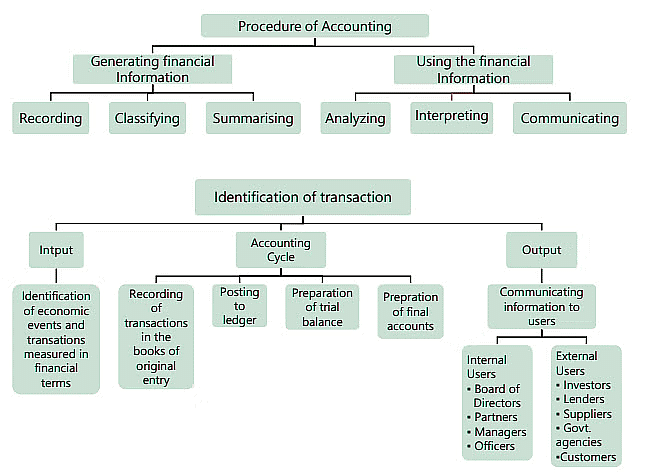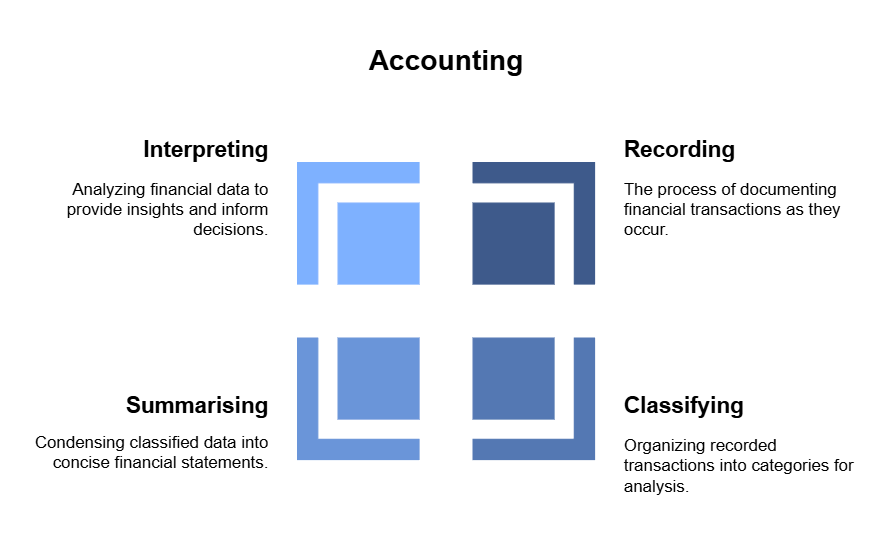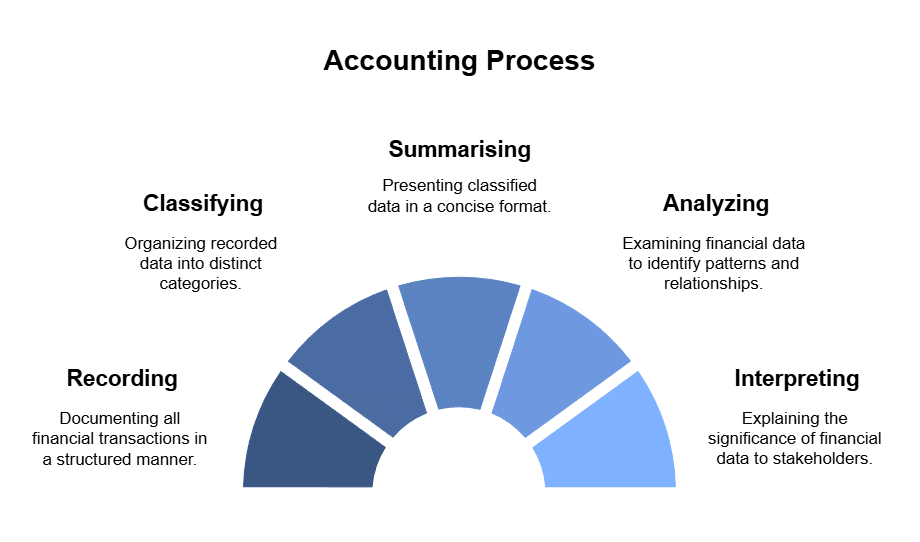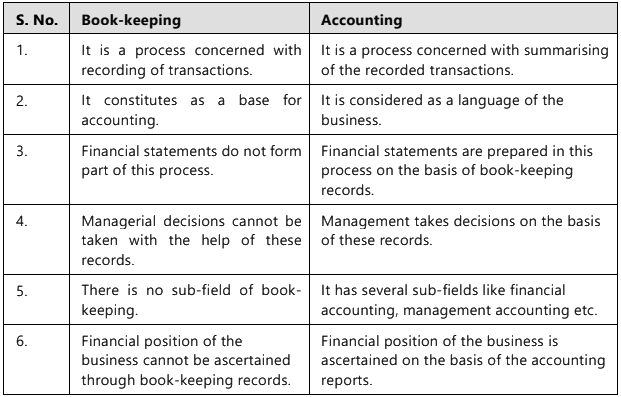Unit 1: Meaning and Scope of Accounting - 1 Chapter Notes | Accounting for CA Foundation PDF Download
Introduction
- Every person engages in some form of economic activity.
- A salaried individual receives a salary and spends it on necessities such as food and clothing, as well as on children's education and home construction.
- Economic activities can be seen in various forms, including:
- A sports club formed by individuals,
- A business operated by a single person or a group,
- A company involved in the telecom sector,
- Local authorities like the Calcutta Municipal Corporation or the Delhi Development Authority,
- Central or State Governments.
- Not all economic activities are conducted for individual gain; some may provide social benefits that serve the public at large.
- Regardless, these economic activities occur through 'transactions and events.
- A transaction refers to a business, the performance of an act, or an agreement,
- while an event signifies a happening that results from one or more transactions.

Example 1:
An individual invests ₹ 2,00,000 to run a stationery business. On 1st January, he purchases goods for ₹ 1,15,000 and sells for ₹ 1,47,000 during the month of January. He pays shop rent for the month ₹ 5,000 and finds that still he has goods worth ₹ 15,000 in hand. The individual performs an economic activity. He carries on a few transactions and encounters with some events. Is it not logical that he will want to know the result of his activity?
We see that the individual, who runs the stationery business, earns a surplus of ₹ 42,000.
Earning of ₹ 42,000 surplus is an event; also having the inventories in hand is another event, while the purchase and sale of goods, investment of money and payment of rent are transactions. Similarly, a municipal corporation got a government grant ₹ 500 lakhs for adult education; it spent ₹ 250 lakhs for purchasing literacy kits, paid ₹ 200 lakhs to the tutors and is left with a balance of ₹ 50 lakhs. These are also transactions and events.
Similarly, the Central Government generates revenue through taxes, pays salaries to employees, and invests in various developmental initiatives. When government receipts exceed expenses, it has a surplus; conversely, if expenses surpass receipts, it operates at a deficit. The process of raising funds through various means can be classified as transactions, while the surplus or deficit at the conclusion of the accounting year can be referred to as an event.
- A telecom company must ensure it delivers services to its millions of users with both post-paid and pre-paid plans. Each user activity (calls, messages, data usage) constitutes an economic event. The company must maintain accurate and timely records to collect payments from post-paid customers for services rendered. Similarly, for pre-paid customers, the company must provide support and ensure records reflect the remaining balance available for use.
- Consequently, it is essential for everyone to maintain records of all transactions and events to acquire adequate information about economic activities, which aids in decision-making. The discipline of accounting has evolved to fulfill this need, as it involves measuring economic activities related to the inflow and outflow of economic resources, thereby generating useful information for the decision-making process.
- Accounting is universally applicable for recording transactions and events, and for presenting relevant information to assist in decision-making concerning any type of economic activity, from family events to national government functions. However, this study material will focus on business activities and their accounting, aiming to provide a fundamental understanding of accounting in the context of business. Nevertheless, it will offer sufficient knowledge to comprehend accounting as a field of study with universal relevance.
- The evolution of the accounting discipline is closely linked to the growth of the business sector. Therefore, to understand accounting as a universal field of study, it is best recognized for its role in recording business transactions and communicating financial information about business enterprises to aid decision-making. The purpose of accounting is to satisfy the informational needs of rational and sound decision-makers, thus earning the title of the language of business.
Meaning of Accounting
The Committee on Terminology established by the American Institute of Certified Public Accountants provided the following definition of accounting in 1961:“Accounting is the art of recording, classifying, and summarising in a significant manner and in terms of money, transactions and events which are, in part at least, of a financial character, and interpreting the result thereof.”

- According to this definition, accounting is fundamentally the art of maintaining records. The accounting process begins with identifying financial transactions and events, which are then recorded in the accounting books. For instance, a telecom company must document all transactions (such as user activities, invoicing, payment receipts, salary payments, marketing expenses, etc.). Similarly, an individual operating a stationery business must also keep track of all business transactions.
- This recording is carried out in journals or subsidiary books, known as primary books. A robust record-keeping system incorporates proper classification of transactions and events, along with their summarization for easy reference. For example, a telecom company handling thousands of daily transactions is not expected to disclose all transactions for decision-making. Hence, these transactions need to be summarized accordingly.
- Once transactions and events are recorded, they are transferred to secondary books, i.e., the Ledger. In the ledger, transactions and events are categorized as income, expenses, assets, and liabilities based on their nature and summarized in the profit and loss account and balance sheet.
- Ultimately, transactions and events must be measured in monetary terms. Measurement in monetary terms involves using the local currency, such as rupees in India or dollars in the USA. Transactions and events should possess at least some financial characteristics. For instance, inaugurating a new bank branch is a non-financial event, while selling a business by the branch is a financial event. Accounting also interprets the recorded, classified, and summarized transactions and events. However, the earlier definition does not encompass the modern accounting function. According to the original definition, accounting concludes with the interpretation of financial transactions and events. In today's world, with the diversification of management and ownership, globalization of business, and increased public interest in enterprise operations, the need for communicating accounting results has grown.
As a result, the necessity for communication and facilitating informed judgment has become part of accounting, as reflected in the widely accepted definition provided by the American Accounting Association in 1966, which states:
“The process of identifying, measuring and communicating economic information to permit informed judgments and decisions by the users of accounts.”
In 1970, the Accounting Principles Board (APB) of the American Institute of Certified Public Accountants (AICPA) outlined the functions of accounting as follows:
“The function of accounting is to provide quantitative information, primarily of financial nature, about economic entities, that is needed to be useful in making economic decisions.”
Therefore, accounting can be defined as the process of recording, classifying, summarizing, analyzing, interpreting financial transactions, and communicating the results to interested parties. This definition necessitates that accountants take on greater responsibility beyond mere bookkeeping. Accountants must be prepared to provide information that is readily accessible and useful for intended users to make economic decisions.
Procedural aspects of Accounting
On the basis of the above definitions, procedure of accounting can be basically divided into two parts:(i) Generating financial information and
(ii) Using the financial information.
Generating Financial Information
- Recording – This fundamental accounting function involves documenting all financial transactions, supported by documents like sales bills, passbooks, and salary slips, in a book known as the “Journal.” This journal may be further categorized into various subsidiary books based on the business's nature and size. Chapter 2 will cover how to prepare journals and different subsidiary books.
- Classifying – This step focuses on systematically analyzing the recorded data to group transactions of similar nature in a compact and usable format. The resulting book is called the “Ledger,” which contains individual account heads where all transactions of similar types are accumulated. For instance, separate account heads may exist for Salaries, Rent, Printing and Stationery, and Advertisement. After recording expenses in the Journal, they are classified into distinct heads in the Ledger, facilitating the tracking of total expenditures under each category. Chapter 2 will also address how to prepare ledger books.
- Summarising – This involves preparing and presenting the classified data in a way that is useful for both internal and external users of financial statements, leading to the creation of financial statements.
- Analysing – Analysis refers to the methodical classification of data provided in financial statements. Financial figures need to be simplified for utility; for example, items related to fixed assets are grouped together while current assets are separately categorized. This process establishes relationships between items in the Profit and Loss Account and Balance Sheet, forming the basis for interpretation. Students will explore this aspect of financial statements in later Chartered Accountancy coursework.
- Interpreting – As the final function, interpreting explains the meaning and significance of relationships established through data analysis. It involves analyzing and interpreting financial data to enable end-users to assess the financial condition and profitability of business operations, explaining not just what occurred, but why and what might happen under certain conditions.
- Communicating – This process involves transmitting summarised, analysed, and interpreted information to end-users, allowing them to make informed decisions. This is achieved through the preparation and distribution of accounting reports, which include the profit and loss account, balance sheet, and additional information like accounting ratios, graphs, and fund flow statements. Students will learn more about this aspect in later Chartered Accountancy courses.

The initial two steps of generating financial information, along with preparing the trial balance, fall under bookkeeping, while the preparation of financial statements, their analysis, interpretation, and communication to various users are considered accounting stages. In upcoming topics, students will learn the distinction between bookkeeping and accounting.
Using the Financial Information
- Accounts have various users. Initially, accounting was thought to serve only the business owner, but evolving social dynamics have changed this perspective. Previously, businesses were simpler and smaller, which may have justified that view.
- Now, it is recognized that besides the owner and management, users of accounts encompass investors, employees, lenders, suppliers, customers, government agencies, and the broader public. For instance, in an airline business, stakeholders such as banks (lending money), oil companies (selling oil), customers (buying tickets), and employees (receiving salaries) all have a vested interest in the company's performance. They seek to understand whether the business is thriving or facing challenges. Accounting provides a methodical presentation of information to its users.
- Accounting data is more beneficial when it emphasizes economic substance over technicality. Information becomes irrelevant if it is not pertinent and significant to user decisions. It should be unbiased, allowing users to assess the reliability of the financial results and compare them with alternative options and past experiences. Internal users, such as owners or management, analyze accounting data to make informed business decisions, requiring information presented differently than for external users. Management reports provide detailed information affecting internal operations, while external financial statements summarize key data regarding assets, liabilities, and capital logically, aiding their decision-making processes.
Evolution of Accounting as A Social Science
History & Development of Accounting
- Accounting has its origins dating back to around 4000 BC when Egyptians utilized some form of accounting for their treasuries.
- The treasury officials were required to submit daily reports to their superiors, known as Wazirs, and monthly reports to the kings.
- In Babylonia, recognized as the center of commerce, accounting was employed to track business losses related to fraud and inefficiency.
- Greece utilized accounting to allocate revenues among treasuries, keeping records of receipts, payments, and government financial transactions.
- Romans maintained a memorandum or daybook for recording receipts and payments (700 B.C. to 400 A.D.).
- China developed advanced government accounting practices as early as 2000 B.C.
- In India, accounting practices can be traced to the time of Kautilya, a minister in Chandragupta’s kingdom, who authored the book Arthashasthra, detailing the maintenance of accounting records.
- Luca Pacioli, a Franciscan friar from the merchant class, published his book Summa de Arithmetica, Geometria, Proportionality in Venice (1494), which is regarded as the first text on double-entry bookkeeping.
- This book included business and bookkeeping knowledge, introducing the terms Debit (Dr.) and Credit (Cr.) from Italian and Latin origins—debit meaning owed and credit denoting trust or belief in the proprietor.
- Pacioli explained that all entries must be double entries; for every credit, there must be a corresponding debit.
- He emphasized the merchant's ethical duty to honour God in their business dealings and to achieve profitability.
- He elaborated on the concepts of memorandums, journals, ledgers, and specialized accounting methods.
- Initially, accounting served stewards in fulfilling their management duties.
- Wealthy individuals employed stewards to oversee their assets, who, in turn, provided periodic accounts of their management—this practice, known as 'Stewardship Accounting', was the foundation of the financial accounting system.
- Stewardship accounting remained prevalent until the rise of large-scale enterprises like public limited companies.
- The second phase saw the emergence of financial accounting alongside the concept of joint-stock companies, which separated ownership from management.
- To protect shareholder interests, laws require disclosure of financial statements, such as profit and loss accounts and balance sheets.
- These statements offered periodic performance reports and financial positions at the end of reporting periods, gaining legal recognition due to changing relationships among owners, economic entities, and managers.
- With societal democratization, the dynamics between enterprises and stakeholders evolved, prompting investors and business contacts to seek extensive information before engaging in transactions.
- Consequently, financial accounting developed as an information system to identify, measure, and communicate relevant information for informed judgments and decisions.
- The third phase introduced Management Accounting, a development of the 20th century, aimed at enhancing the quality of management decisions across various spheres.
- Finally, Social Responsibility Accounting is currently developing, focusing on accounting for the social costs incurred by businesses and the social benefits they create.
- This evolution reflects a growing awareness of the negative consequences of economic activities.
- In the pursuit of profits, businesses often incur social costs such as pollution and resource usage.
- Therefore, it is expected that businesses also generate social benefits, including job creation, recreational opportunities, and improved product quality at reasonable prices.
- As such, the accounting system is called upon to report on the social costs incurred and the social benefits generated.
- Social Science examines individuals as members of society, focusing on social processes and the outcomes of social relationships.
- The overall benefit of accounting to society is the primary criterion for considering it a social science.
- While individuals may gain from accounting information, the system ultimately produces information for the greater social good, contributing to social progress and adapting to societal changes.
- Hence, accounting is recognized as a social science.
Objectives of Accounting
The objectives of accounting can be summarized as follows:
- Systematic recording of transactions: The primary goal of accounting is to systematically document the financial aspects of business transactions, which refers to bookkeeping. These recorded transactions are subsequently classified and summarized logically to prepare financial statements for analysis and interpretation.
- Ascertainment of results of recorded transactions: Accountants generate profit and loss accounts to determine the outcomes of business operations over a specific period. If revenue (Sales) exceeds expenses, the business is deemed profitable; conversely, if expenses surpass revenue, the business incurs a loss. The profit and loss account aids management and stakeholders in making informed decisions. For instance, if the business is not profitable, management can investigate the reasons and take corrective actions.
- Ascertainment of the financial position of the business: Business owners are not only interested in the profit or loss results over a period but also want to know their liabilities to outsiders and their assets at a specific date. To provide this information, accountants prepare a financial position statement, commonly known as the Balance Sheet. This statement outlines the assets and liabilities of the business at a certain moment, helping to assess its financial health.
- Providing information to users for rational decision-making: Accounting serves as the 'language of business' by communicating the financial results of an enterprise to various stakeholders through financial statements. It aims to satisfy the informational needs of decision-makers, facilitating rational decision-making.
- To know the solvency position: By preparing the balance sheet, management not only reveals the ownership and debts of the enterprise but also provides insights into its ability to fulfill its liabilities in the short term (liquidity position) and long term (solvency position) as they become due.
An overview of objectives of accounting is depicted in the chart given below:
Functions of Accounting
The primary functions of accounting are as follows:- Measurement: Accounting evaluates the historical performance of the business entity and illustrates its current financial status.
- Forecasting: Accounting assists in predicting future performance and financial condition of the enterprise by utilizing past data and analyzing trends.
- Decision-making: Accounting delivers pertinent information to users of accounts to facilitate informed decision-making.
- Comparison & Evaluation: Accounting measures performance achieved against targets and reveals information regarding accounting policies and contingent liabilities, which are crucial for predicting, comparing, and assessing financial results.
- Control: Accounting identifies weaknesses in the operational system and provides feedback on the effectiveness of measures implemented to address such weaknesses.
- Government Regulation and Taxation: Accounting supplies essential information to the government for controlling the entity and for tax revenue collection.
Book Keeping
Bookkeeping is an activity focused on the systematic and orderly recording of financial data related to business operations. It encompasses the procedural aspects of accounting work and includes the function of record-keeping. The procedures of bookkeeping are influenced by the final output, which consists of financial statements. The term “financial statements” refers to the Profit and Loss Account, Balance Sheet, and cash flow statements, along with Schedules and Notes that are part of the Accounts.- Bookkeeping also requires appropriate classification of transactions and events, which is determined by the needs of the financial statements. A bookkeeper may manage all records of a business or only a specific section, such as customer accounts in a retail store. Accounting relies on an effective and meticulous bookkeeping system.
- The primary purpose of maintaining bookkeeping records is to accurately reflect the status of each income and expense category. A business may acquire goods on credit as well as with cash. When acquiring goods on credit, it is essential to document the creditor. The business owner may wish to periodically review the outstanding amounts for credit purchases and their respective creditors. Without proper record-keeping, it becomes challenging to obtain details about transactions concerning income and expenses. At the end of the accounting period, the owner seeks to determine the profit earned or loss incurred, which requires extensive information gathered from a well-maintained record of transactions. Thus, the proper management of accounting books is crucial for any business.
- At this level, the curriculum primarily focuses on bookkeeping and the preparation of financial statements. It is important to note that bookkeeping and financial statement preparation have legal implications. The maintenance of accounting books and the creation of financial statements for a company are regulated by the Companies Act, while banks and insurance companies are governed by specific legislation. However, for sole proprietorships and partnerships, there are no specific laws mandating the maintenance of accounting books and the preparation of financial statements.
Objectives of Bookkeeping
- Complete Recording of Transactions – This involves a thorough and permanent record of all transactions in a systematic and logical manner to demonstrate their financial impact on the business.
- Ascertainment of Financial Effect on the Business – This pertains to understanding the overall impact of all transactions during the accounting period on the business's financial position.
Distinction Between Book-Keeping And Accounting
Many individuals confuse bookkeeping and accounting as identical concepts; however, they are distinct from one another. Accounting encompasses a wider scope, requiring a deeper comprehension of the records generated from bookkeeping, along with skills to analyze and interpret the information these records contain. Bookkeeping involves the recording stage, whereas accounting focuses on the summarization stage of an accounting system. Bookkeeping supplies essential data for accounting, which begins where bookkeeping concludes.
The relationship of Accounting and Book-keeping can be depicted in the following chart as
|
68 videos|160 docs|83 tests
|
FAQs on Unit 1: Meaning and Scope of Accounting - 1 Chapter Notes - Accounting for CA Foundation
| 1. What is the meaning of accounting? |  |
| 2. How has accounting evolved as a social science? |  |
| 3. What are the main objectives of accounting? |  |
| 4. What are the key functions of accounting? |  |
| 5. What is the distinction between book-keeping and accounting? |  |




















